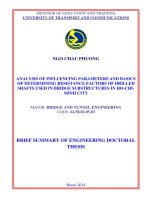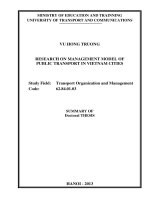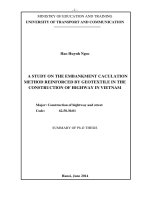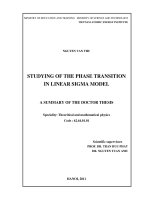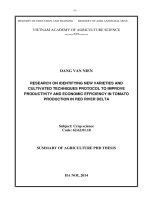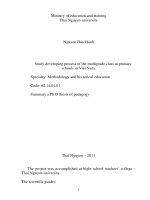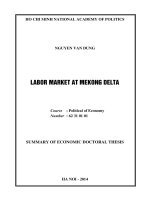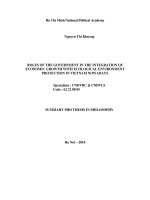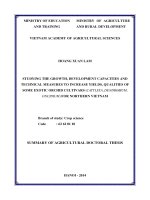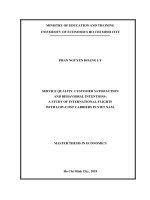Summary of Economic Doctor thesis: Counteracting transfer pricing in corporate income tax in Viet Nam
Bạn đang xem bản rút gọn của tài liệu. Xem và tải ngay bản đầy đủ của tài liệu tại đây (535.73 KB, 32 trang )
MINISTRY OF EDUCATION
MINISTRY OF FINANCE
AND TRAINING
ACADEMY OF FINANCE
TO HOANG
COUNTERACTING TRANSFER PRICING IN CORPORATE
INCOME TAX IN VIET NAM
MAJOR: Finance Banking code: 9.34.02.01
SUMMURY OF ECONOMIC DOCTOR THESIS
HÀ NỘI 2020
The work was completed at the Academy of Finance
Sicientific instructor: 1. Assoc.Prof: Vương Thị Thu Hiền
2. Assoc.Prof: Bạch Thị Thu Hiền
Frist review:
Second review:
Third review:
The thesis will be defended at the Academylevel
Thesis Judging Council, at Finance institutions.
At ... time .......... date ......... month. 2020
Specifically, find out the thesis at the National Library
and the Academy Library Finance
5
INTRODUCTION
1. Urgency of the researching topic
With the policy of developing a multicomponent economy, actively and
proactively integrating into the international economy, Vietnam's
international relations with other countries in the world have been
increasingly expanded, with the source of capital investment from
economic components having been gradually canalized. Putting to invest
in production and business activities, creating a solid motivation for the
development of the economy
In addition to the achievements of international economic integration,
the impacts from the negative side of the market economy when
penetrating into Vietnam and continuing to develop complexly. One of
these impacts is the phenomenon of enterprises transferring prices, evading
taxes, causing losses to the State budget and creating an unequal
environment in business.
Transfer pricing activities in enterprises in our country takes place
continuously, everywhere, at all times, causing great losses to the State
budget and causing many consequences for the economy. Although State
Agencies have been making efforts to improve institutions and organizing
coordination in the inspection and checking of transfer pricing. However,
the achieved results are still very low. Transfer pricing activities have not
yet been prevented, pushed back, causing many negative effects in the
society.
In the context of the mentioned situation, the author decided to choose
the thesis topic: “Anti transfer pricing in corporate income tax
management in Vietnam", with the desire to research and propose some
theoretical solutions based on practical science and in accordance with
Vietnamese situation, contributing to strengthening antitransfer pricing in
corporate income tax (CIT) management in Vietnam in the near future.
With this meaning, the research of the thesis topic is very necessary and
highly topical.
2. Objectives and tasks of researching the topic
Overall objectives:
Researching and proposing a number of solutions with scientific
arguments and being suitable with Vietnamese reality, in order to enhance
antitransfer pricing in the management of corporate income tax in
Vietnam in the coming time.
Detail goal:
Systematize and clarify some basic theoretical issues on transfer
pricing and antitransfer pricing in corporate income tax management, as a
foundation for analyzing, assessing the situation and proposing solutions
of the strengthening antitransfer pricing in corporate income tax
management in Vietnam in the coming period.
Refer to the experience of antitransfer pricing of some countries in the
world to apply in corporate income tax management in Vietnam.
Analyze and evaluate the status of transfer pricing and antitransfer
pricing in corporate income tax management in Vietnam.
Proposing some solutions with scientific and suitable with the actual
situation of Vietnam arguments in order to strengthen the antitransfer
pricing in corporate income tax management in our country in the coming
time.
3. Subject and scale of research
Research subject of the topic:
Transfer pricing and antitransfer pricing in corporate income tax
management.
Research scope:
Regarding content: This topic only focuses on researching transfer
pricing activities and antitransfer pricing activities in corporate income
tax management.
Regarding time: The thesis focuses on transfer pricing and antitransfer
pricing activities from 2010 to 2019, after the determination of market
prices in transactions between affiliated parties in Vietnam. Follow the
7
instructions in Circular 66/2010 / TTBTC. Proposing some solutions to
apply for the period from 2020 to 2025 and vision to 2030.
In terms of space: The research focuses on transfer pricing and anti
transfer pricing of tax authorities in some major cities such as Hanoi, Hai
Phong, Ho Chi Minh ... are concentrated areas and There are many typical
models of the whole country on transfer pricing and antitransfer pricing in
corporate income tax management.
4. Data and research methods
Research data:
The figures in the thesis include the macro data on Vietnam's economy,
the micro data of annual surveying enterprises of the General Statistics
Office, the Ministry of Planning and Investment, and the General
Department of Taxation.
Research Methods: The thesis uses a combination of scientific research
methods, taking dialectical materialism, historical materialism as the
methodological foundation. At the same time, using a combination of
research methods to achieve research objectives. Specifically:
Dialectical materialism and historical materialism: are used to better
clarify the issues of transfer pricing and antitransfer pricing.
Methods of collecting and processing information: used to collect
primary and secondary documents. These are financial statements of
enterprises having associated transaction relations, reports on inspection
results, specializing seminars of transfer prices of the General Department
of Taxation and some local Tax Departments; a number of conclusions on
inspection of violations of tax obligations in general, doubts of transfer
pricing in particular of the Ministry of Finance and the State Audit;
relevant legal documents, related reports, schemes and programs of the
Ministry of Finance, the Ministry of Planning and Investment, the General
Department of Taxation, the General Department of Statistics and tax
offices of a number of provinces and cities city. Along with that are
projects, scientific researches, domestic and foreign articles related to
transfer pricing and antitransfer pricing.
Statistical method (tables, graphs ...): is used to synthesize and
organize the collected data to more visually reflect the reality of the
research issues.
Qualitative analysis method: is used on the basis of awareness of
theories, analysis results, assessment of the real situation, limited
problems, causes ... to interpret and recommend, proposing some solutions
to the research problem.
Expert method: used in reference to the views and opinions of experts
who are experienced tax officials and tax officials with professional
knowledge in the field of inspection of antitransfer pricing; indirectly
quoting experts' points posted on relevant research topics and articles.
Quantitative method: The thesis uses quantitative research methods to
assess the impact of the antitransfer pricing inspectorate in the
management of corporate income tax on transfer pricing activities of
enterprises.
Based on the application of the Servperf model, the dissertation has
built a questionnaire and consulted some experts who are tax officials with
experience in antitransfer pricing inspections and opinions of some
scientists. Under the support of SPSS application version 20 (Statistical
Package for the Social Siences), being a computer application that is used
quite commonly in sociological statistical analysis, primary data through
quantitative surveys, clearly showing the factors affecting the results of
antitransfer pricing inspections from tax officials. From the empirical
results, the author will give implications for proposing solutions to
enhance the effectiveness of the antitransfer pricing inspection.
5. New contributions of the thesis
The dissertation topic has the following new contributions:
The dissertation summarizes and systematizes some basic theoretical
issues on transfer pricing and antitransfer pricing in corporate income tax
management.
The thesis comprehensively and objectively analysize and assess the
current situation of transfer pricing and antitransfer pricing in corporate
9
income tax management in Vietnam from 2010 to 2019. On that basic,
showing the achieved results, limitations and causes of restrictions on
transfer pricing in corporate income tax management in our country.
Typical content of the new contributions of the thesis was discovered
through the survey of assessments of tax officials on the impact of tax
inspection in antitransfer pricing in corporate income tax management,
identifying the factors affecting the results. antitransfer inspection results,
the level of impact of those factors.
Proposing a number of solutions with scientific arguments, suitable
to the reality of Vietnam's socioeconomic situation in order to promote
antitransfer activities in the management of corporate income tax in the
coming time. In particular, the key solution was studied by the dissertation
on skills in antitransfer pricing inspections in corporate income tax
management so that the inspection can be highly effective, promoting the
prevention of transfer pricing of enterprises.
6. Scientific and practical significance of the thesis
Scientific significance: Systematic research thesis with theoretical
content about transfer pricing and antitransfer pricing, helps to evaluate
and delve into achieved results, analyze limitations, and the cause of the
limitations to propose solutions to combat transfer pricing in corporate
income tax management in the period of 2020 to 2025 and vision to 2030.
Practical significance: On the basis of analyzing and assessing the true
situation of antitransfer pricing in corporate income tax management in
Vietnam today, the thesis proposes a number of realistic solutions to
combat transfer pricing in corporate income tax management. in the
coming time, directly contributing to limit the loss of State budget revenue
7. The structure of the thesis topic
In addition to the introduction, conclusion and appendices, the content
of the thesis consists of 4 chapters:
Chapter 1: Overview of research on transfer pricing and antitransfer
pricing
Chapter 2: Basic theory of transfer pricing and antitransfer pricing in
corporate income tax management
Chapter 3: Current situation of transfer pricing and antitransfer
pricing in corporate income tax management in Vietnam
Chapter 4: Some solutions to enhance antitransfer pricing in corporate
income tax management in Vietnam
CHAPTER 1
OVERVIEW OF RESEARCH ON TRANSFER PRICING AND
ANTI TRANSFER PRICING
1.1. Research works on transfer pricing and antitransfer pricing
activities
The thesis has referred to a number of typical works the author has
studied: 6 works of monographs, 3 foreign scientific newspapers; 2
textbooks, monographs, 7 theses, desertation, 4 indepth research articles
on transfer pricing and domestic antitransfer price transfer. In addition,
there are many research articles on transfer pricing and antitransfer
pricing issues from different perspectives.
1.2. Research works on corporate income tax and management of
corporate income tax
The indepth studies on corporate income tax and corporate income tax
management have been studied by the author for the thesis: 3 foreign
research projects; 9 works reseracing in the country. There are also a
number of other directly related documents and articles.
1.3. General assessment of related research works
The research is an important document that helps the author to inherit
and clarify the transfer pricing issue and the impact of transfer pricing in
corporate income tax management in Vietnam. However, it is necessary to
have more specific research on the impact of transfer pricing on corporate
11
income tax and the issue of antitransfer pricing in the management of
corporate income tax in Vietnam in the context of Vietnam having been
intergrated deeply and widely. In the context of the world economy, there
are many complicated changes like the current period. On the basis of
continuing selection of inherited research results. The thesis focuses on
clarifying a number of unresolved issues in previous studies, namely:
Regarding to theority: (1) The thesis continues to inherit
systematically the theoretical issues of transfer pricing and antitransfer
pricing to reinforce and clarify the issues of transfer pricing and anti
transfer pricing in management. CIT. (2) dissertation systematize and
provide theoretical basis to evaluate the impact of factors affecting agents
in the economy. Develop econometric models to analyze the impact of
antitransfer pricing inspections in corporate income tax management.
Regarding to practice: (1) The dissertation systematizes international
experiences of some countries on antitransfer pricing as a basis for
reference for Vietnam. (2) The thesis analyzes and assesses the status of
transfer pricing and antitransfer pricing in corporate income tax
management in Vietnam through primary and secondary data. (3) The
thesis proposes a number of measures to enhance antitransfer pricing in
corporate income tax management in Vietnam in the coming time, in
accordance with the international and Vietnamese economic context.
1.4. Research questions and research content
In order to carry out the research objectives, the thesis needs to answer
the following questions: (1) How does price transfer affect corporate
income tax management in Vietnam? (2) What are the experiences of
countries in tax administration to prevent transfer of prices among
associated businesses? (3) What is the current situation of transfer pricing
and antitransfer pricing activities in corporate income tax management in
Vietnam over the past time? (4) What solutions are needed to limit transfer
pricing enterprises causing loss of corporate income tax in Vietnam in the
current context? How to deploy an antitransfer pricing inspection to be
effective, convincing and deterrent of transfer pricing enterprises to usurp
CIT in Vietnam?
CHAPTER 2
BASIC THEORY OF TRANSFER AND
ANTI TRANSFORMATION IN CIT MANAGEMENT
2.1. Theories about transfer pricing
2.1.1. Concept of transfer pricing
Transfer pricing is the implementation of the price policy in transactions
between related parties that do not follow the market price in order to
achieve many different targets, in which the main target is to minimize the
payable tax liability to maximize profits of corporations, multinational
companies, associated businesses.
2.1.2. Characteristics of transfer pricing
Transfer pricing in associated party transactions has the following basic
characteristics: (i) Only happens among associated enterprises; (ii)
Transaction prices are not based on market prices; (iii) After transferring,
the corporate income tax of the whole group decreases, the total profit of
the whole group increases. (iv) Control and prevention of transfer pricing
are difficult due to the enterprise’s permission freely to decide on prices.
2.1.3. The cause of transfer pricing
13
Associated businesses may redefine prices in goods in exchange
transactions for the following reasons: (i) The right to freely determine the
prices of goods and services of the enterprise; (ii) The corporate income
tax obligations of the whole system will change, leading to a change of
profit after tax of the whole system; (iii) Transfer pricing occurs when
there are certain conditions related to the components of CIT, such as
differences in CIT rates, CIT incentives, accounting systems, and views to
determine CIT. between businesses with associated relations.
2.1.4. Forms of transfer pricing in associated businesses
2.1.5. Impact of transfer pricing
The impact of price transfer to associated businesses
The impact of price transfer to the country or region where having the
busineses are transferred profit.
The impact of price transfer to countries and localities where busineses
receive investment.
2.2. Antitransfer pricing in corporate income tax management
2.2.1. Enterprise income tax management
Tax administration is understood as the operation of the tax
administration agency in order to influence and manage the compliance
with tax laws of taxpayers.
2.2.2. Antitransfer pricing in corporate income tax management
Antitransfer pricing in corporate income tax management is the
application of appropriate methods by the authorities to restrict and
proceed to eliminate the transfer pricing activities of associated businesses
in order to limit loss of corporate income tax.
Antitransfer pricing in corporate income tax management is
implemented by redetermining transfer prices between associated
transactions that do not follow independent transaction prices, falsifying
grounds for determining CIT.
2.3. Experience of antitransfer pricing in corporate income tax
management in a number of countries around the world
The dissertation researches the experience of antitransfer pricing of
a number of countries with many economic groups, many multinational
companies such as the US, UK, France, China ... summarizing some
experiences on antitransfer pricing of National antitransfer pricing:
There must be a complete and reasonable legal corridor to serve as a
basis for controlling and combating transfer pricing activities.
The method of determining transfer prices must be selected in
accordance with the domestic socioeconomic situation and speeding up
the signing of tax treaties with other countries.
There should be severe sanctions, clearly defined and strictly enforced.
Organizing a force of antitransfer pricing in tax offices strong enough
in both quantity and quality.
Developing and perfecting the database system and data link so tax
authorities can refer and compare when there is a question about transfer
pricing.
Limiting the factors that create an environment stimulating transfer
pricing activities in attracting investment.
The business income tax contributed by businesses always plays an
important role in the total State budget revenue, always stable from 15% to
17% of the total domestic revenue of the tax industry.
CHAPTER 3
CURRENT SITUATION OF TRANSFER AND ANTITRANSFER
IN THE MANAGEMENT OF CIT IN VIETNAM
3.1. Situation of attracting investment capital in Vietnam over time
3.1.1. These achievements
Investment capital putted into production and business activities in
recent years have been increasing , forcing economic development. From
2010 to 2019, Vietnam's economy continued to maintain at an average
annual growth rate of 6.35% while the world economic growth rate
averaged 3.48%.
The business contribution to social products is increasing. According
to statistics of the total revenue of businesses in the country in 2019
increased by 4 times the total revenue in 2010, the total profit before tax of
15
the businesses in 2019 increased by 100 times compared to the profits of
enterprises in the year. 2010.
Corporate income tax contributed by businesses always plays an
important role in the total State budget revenue, always stable from 15% to
17% of the total domestic revenue of the tax industry.
3.1.2. The existence
The feasibility and efficiency of production and business of some
projects, some enterprises are not high, the rate of enterprises declaring
losses is from 40.89% (2014) to 46.25% (2017) number of active
businesses. In particular, the proportion of FDI enterprises reported the
highest losses in all economic sectors, accounting for 48.59% (in 2018) to
53.78% (in 2012).
The structure of investment capital is still unreasonable compared to
the orientation of investment for socioeconomic development of the
country: the proportion of investment capital for agriculture, forestry and
fishery tends to decrease; poor socioeconomic areas with few investment
projects.
The proportion of foreign investment projects using high technology,
source of technology is still low, the added value of products created in
Vietnam is not high.
The impact of spillover, connection and creating value chains with
domestic enterprises has not been as expected. Technology transfer to
domestic enterprises is very limited.
3.2. Actual situation of transfer pricing among related
businesses Vietnam
3.2.1. Transfer pricing through interest payments
The form of transferring price through interest payment has been found
to be quite common among associated businesses in Vietnam, especially
FDI enterprises. Instead of foreign having to invest more capital in the
Vietnamese associated party, the foreign party will switch to the way to
lend more capital with the high interest rate. A typical example of transfer
pricing through interest payment has been discovered in the past case of
Keangnam Vina Co., Ltd. The company has been discovered by the tax
authorities to transfer prices through interest expenses, 43.67 billion VND
of tax arrears; administrative fine of VND 2.1 billion; slow payment of
VND 5,344 billion.
3.2.2. Transfer pricing by raising the value of assets upon establishment
or capital contribution
This type of transfer pricing is often done by foreign investors due to the
advantages of modern machinery, equipment and technology. On the other
hand, because the Vietnamese lacks the capacity, qualifications and
information to appraisal; moreover, evaluatting the types of equipment and
technology contributed by the foreign party to the joint venture often have
to accept the value setted by the partner.
3.2.3. Transfer prices by putting unprecisely the value of initial fixed
assets
Taking advantage of the advantages of foreign new technologies, along
with limitations on Vietnam's price appraisal, when receiving investment,
the Vietnamese often has to accept the prices setted by foreign partners.
Many foreign enterprises investing in Vietnam have implemented transfer
pricing by the way of raising the value of machinery and equipment higher
than the actual price,with a purpose of enhancing the value of capital
contribution, causing chronic losses in Vietnam by the way of not paying
corporate income tax in Vietnam.
3.2.4. Transfer pricing via commercial license fees
The phenomenon of FDI enterprises in Vietnam cooperating with their
parent companies in foreign countries to calculate the cost of franchising
with high costs has also occurred in Vietnam; for example for the case of
Metro Cash & Carry Vietnam.
3.2.5. Transfer prices via input materials
In some specific fields, input materials depend on foreign suppliers,
foreignlinked enterprises who do transfer prices through raw material
17
prices which have been discovered in Vietnam. But many cases are
difficult to handle because the Vietnamese tax authorities lack an
independent price for comparison. Typically, like the case of Coca Cola
Vietnam Co., Ltd.
3.2.6. Transfer prices by declaring large selling expenses
Many commercial enterprises distribute exclusive products to foreign
businesses to increase selling costs both to compete with domestic goods
and to increase costs so that they do not have to pay corporate income tax
in Vietnam.
3.2.7. Transfer pricing by declaring too much of intermediary input cost
With the increase of intermediary input costs from the parent enterprise
to the subsidiary in Vietnam is not true and unrealistic, leading to the fact
that the subsidiary enterprises in Vietnam suffer losses and do not have to
pay CIT for many years.
3.2.8. Transfer prices from enterprises that are no longer eligible for tax
incentives, to those that are eligible for CIT incentives
The phenomenon of transfer pricing among enterprises be favored CIT
incentives and also carrying forward losses, has been found not only in
FDI enterprises but also among enterprises having association with
domestic capital.
3.2.9. Transferring prices from production and exploitation enterprises
to circulating consuming enterprises
There have been cases of domestic enterprises producing and exploiting
natural resources transferring prices to each other.
3.2.10. Transfer pricing of enterprises in the real estate business that has
a linkage between foreign businesses and domestic businesses
Foreign investors invest in Vietnamese real estate in three main ways:
capital contribution, enterprises stake purchase and investment loan. In
particular, the model associated with domestic enterprises is the "favorite"
cooperation mode of foreign FDI enterprises. Through this way,
businesses transfer prices to minimize the amount of CIT payable in
Vietnam
3.3. The situation of antitransfer pricing in corporate income tax
management in Vietnam
3.3.1. These achievements
The legal provisions related to antitransfer pricing in corporate income
tax management have issued many documents related to antitransfer
pricing issued to guide antitransfer pricing in accordance with
international practice, in accordance with fact in Vietnam.
The implementation of antitransfer pricing in corporate income tax
management has been widely implemented by the tax industry,
investment, and human resources increase from the General Department of
Taxation to a number of localities.
Step by step build infrastructure and environment to build the database
system of tax industry
Deploying step by step for businesses to apply the method of price
determination in associated transactions (APA) in Vietnam. There have
been 31 applications for APA application, of which 24 are in the
consultation stage and 07 have moved to the official application stage of
APA application.
The inspection of antitransfer pricing has been strengthened, there
have been many cases of transfer pricing detected, collecting a lot of tax
money back to the State budget.
Table 3.1: Results of antitransfer price inspections
Currency: VND billion
NUMBER
OF
INSPECTIO
N
YEAR
2012
1
A MOUNT OF CIT
INCREASING
COLLECTION,
PENALITY
78,10
REDUCTION OF
LOSS
956,40
19
2013
2014
2015
2016
2017
2018
2019
(First 6 months
of the year)
31
42
320
315
546
758
499,60
625,00
563,00
747,55
2.020,00
1.908,30
1.383,61
9.126,00
2.238,23
5.568,15
9.001,00
8.558,58
80
1444,03
947,24
(Source: General Department of Taxation)
3.3.2. Evaluating the effectiveness of antitransfer pricing in corporate
income tax management through tax inspection
The objectives of this content are: Indicate the theoretical basis of the
factors affecting the effectiveness of the antitransfer pricing inspection in
corporate income tax management; Develop an effective impact
assessment model for antitransfer pricing audits in corporate income tax
management; Assess the impact of factors to have more bases to propose
antitransfer pricing solutions in corporate income tax management in
Vietnam.
* Theoretical basis:
The effectiveness of antiprice transfer in corporate income tax
management through tax inspection depends on many different factors: the
provisions of law; organize anti transfer pricing’s apparatus; databases
serving for comparison and contrast; the cooperation of domestic and
foreign agencies, organizations ... and the object making transfer pricing
itself is the enterprises.
Model and a preliminary scale
Figure 3.1Model study of the impact of antitransfer pricing factors in
corporate income tax management through tax inspection
(Source: Research synthesis of many authors)
H1: System of legal documents related to tax administration, related to
antitransfer pricing inspections;
H2: Organizing the implementation of the antitransfer pricing
inspection;
H3: Human resources for tax inspection officers;
H4: Information source for inspection;
H5: Coordination of taxpayers;
H6: Coordination of functional agencies, related organizations.
*Qualitative research methods
Researching the factors affecting the effectiveness of antitransfer
inspection in the corporate income tax management was consulted by the
author through direct interviews with experts who are experienced in anti
transfer pricing inspections of the industry. tax; through the advice of
scientists.
*Quantitative research model
On the basis of applying the Servperf model, the thesis has built a
questionnaire of 6 independent variables and 1 dependent variable with 30
component scales.
21
The prescribed composition of the law (PL) is measured by 5 observed
variables, from the observed variable PL1 to PL5;
The composition of organization of the implementing the antitransfer
pricing (TC) inspection is measured by 5 observed variables, from the
observed variable TC1 to TC5;
Human resource for antitransfer pricing (NL) inspection is measured
by 5 observed variables, from NL1 to NL5;
The composition of data and information in service of the antitransfer
pricing inspection (TT) is measured by 4 observed variables, from TT1 to
TT4;
The composition of the taxpayer's coordination (DN) is measured by 4
observed variables, from DN1 to DN4;
The composition of the coordination of related agencies and units (PH)
is measured by 4 observed variables, from PH1 to PH4;
The results of the antitransfer inspection activities in corporate income
tax (KQ) management are measured by 3 observed variables.
Component questions use a 5point Likert scale of 1 to 5 (1Strongly
Disagree; 2 Disagree; 3 Reward; 4 Agree; 5 Strongly Agree).
* Sample design and data collection
The questionnaire was sent to 300 tax officials working in the 20 major
tax departments of cities and provinces through the internal tax email
system. The result was 230 valid votes.
*Descriptive statistics
(1) Regarding the effectiveness of the antitransfer pricing inspections:
over 64% of tax officials participating in the survey assessed the results of
antitransfer inspection activities and found significant violations of
transfer pricing. In addition to the law, the transfer pricing was detected in
accordance with the law, through the inspection against transfer pricing,
the tax administration also detected limitations and always recommended
and supplemented. So that the policy of antitransfer pricing is suitable for
the practical situation in Vietnam.
(2) Regarding the content of tax officials expected to improve the
effectiveness of antitransfer pricing in corporate income tax management
Through the survey, the author has collected some contents. The
surveyed opinions serve as a basis for reference to suggest antitransfer
pricing solutions in corporate income tax management.
*Result of implement
The questionnaires were updated, assessed to determine the reliability,
analyzed the impact of influencing factors on SPSS 2.0 sociological survey
software. Results obtained standardized regression equation:
KQ = 0.387TC + 0.380TT + 0.375PL + 0.3304NL + 0.081PH + a
In which: KQ: Effective against transfer pricing through inspection; TC:
Organization of inspection implementation; TT: Information and data
serving the inspection against transfer pricing; PL: System of legal
documents; NL: Human resources inspector; PH: Coordination of agencies
and organizations involved in antitransfer pricing.
Therefore, it can be said that: with the reliability of 72.3%, it is possible
to evaluate the results of antitransfer pricing in corporate income tax
management through tax inspectors which are mainly affected by 5 factors
arranged in descending order according to Importance of these factors to
the effectiveness of antitransfer pricing inspectors in corporate income tax
management. They are: Organizing the implementation of the inspection
(TC); Information to serve the antitransfer pricing (TT) inspection; The
system of legal documents (PL); Human resources for inspection (NL);
The coordination of agencies and organizations involved in antitransfer
pricing (PH). This conclusion is an important basis for the next chapter to
recommend measures to strengthen antitransfer pricing in corporate
income tax management.
3.3.3. Limitation
Firstly, transfer pricing activities are increasing in both quantity and
scale, increasingly sophisticated in form and large in content but have not
been prevented and repulsed, the number of businesses having a related
relationship. There are still few inspections.
23
Secondly, the number of associated businesses that selfdeclare
association information is limited.
Thirdly, the scope of the inspection and antitransfer pricing control in
corporate income tax management is still limited to the scope of
enterprises having decisions on inspection and examination.
Fourth, the quality of many antitransfer pricing inspections and checks
remains low.
Fifthly, in the inspection and examination work, it is still embarrassing
to identify related parties, compare prices and handle transfer pricing
inspection results.
Sixth, the results of APA implementation are still limited.
3.3.4. The reason causing limitation
* Objective reasons
Starting from the economy of Vietnam since the international economic
integration was still low, the material and technical facilities in service of
state management are still backward not meeting the management
requirements.
There is a lack of cooperation of related units to join hands to combat
transfer pricing.
* Subjective reasons
Firstly, the legal framework is still not perfect, completed for serving for
the struggle against transfer pricing.
Second, incentives in corporate income tax policy create fertile land for
transfer pricing activities of associated businesses.
Thirdly, the organization of the professional antitransfer inspection
force is still lacking in quantity and quality.
Fourthly, the database for detecting and com bating transfer pricing is
still limited in terms of data of related parties and price basis.
Fifth, the coordination and cooperation between domestic and foreign
units is limited
Sixth, funding for antitransfer pricing activities is limitted.
CHAPTER 4
SOME SOLUTIONS TO STRENGTHENING TRANSFER IN THE
MANAGEMENT OF CIT IN VIETNAM IN THE NEXT TIME
4.1. The context of the world and Vietnam economy in the coming
time and the issues raised for the antitransfer pricing in corporate
income tax management
4.1.1. International and Vietnam economic context in the period of 2020
2025
According to forecasts of economic experts on the development of the
global economy in the future: The scale of global foreign investment flows
tends to decrease. The rise of protectionism and antiliberalization of
multilateral trade in some developed countries. The occurrence of the
Covid19 epidemic caused many production stages in different countries to
be reconsidered. The development of the technological revolution will
create many changes in production. Competition to attract investment
among countries in the region continues to increase.
The trend of developing the world economy that will affect Vietnam's
economy is: attracting investment in the direction of paying more attention
to efficiency and quality; The policymaking thinking about investment
and technology transfer also needs to be renewed so that it can keep pace
with the constant changes of technology life.
4.1.2. Issues raised against antitransfer pricing activities in corporate
income tax management
The pressure from deeper and deeper international economic
integration has created opportunities and challenges for businesses in
Vietnam.
25
Increasing competition in production and business activities will lead
to the development of affiliated enterprises, large economic groups and
multinational companies. .
The spread of the Covid19 pandemic will change the investment form
of multinational companies, economic groups, warning the increase in
transfer pricing activities in Vietnam in the near future.
Policy of attracting investment increases the transfer pricing activities
of businesses.
Increasing specialization in production makes price transfer more
complicated.
The increase in the development of prestige values, brands, intellectual
property in goods and services makes the transfer operation more difficult
to control.
Pressure on business profits makes transfer pricing activities
increasingly
The tax incentive policy to attract investment makes Vietnam's tax
policy complicated, and there are gaps for associated companies to take
advantage to avoid taxes through transfer pricing.
Pressure on the rapid development of associated businesses will
increase the complexity of transfer pricing between businesses.
Requirements to replace tariffs with domestic taxes are always
accompanied by growing concerns about transfer pricing activities
between businesses.
The trend of converting jointventure companies into enterprises with
100% foreign capital is increasing, leading to an increase in price transfer.
4.2. Views on antitransfer pricing in corporate income tax
management
Need to eliminate the view to attract investment at all costs.
